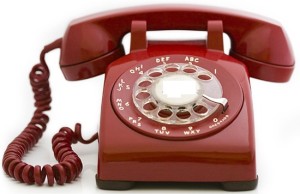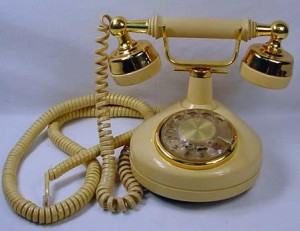How Does A Rotary Dial Phone Operate
A rotary dial telephone was a popular type of phone design throughout the 20th century. This communication device dials numbers in a very different way to the more modern push-button systems we’re familiar with today, requiring the user to rotate a numbered dial to key in digits rather than press a series of buttons.
The rotary dial works on a pulse-based system. The frequency of pulses is determined by the number on the dial which the caller selects, with the user manually turning the dial to a fixed point with their finger before releasing it.
This causes the dial to return to its starting position due to an internal recoil spring, while simultaneously generating a series of electrical pulses that interrupt the flow of current on the telephone’s line.
These pulses correspond to the digit selected, so if the user rotates the dial from, say, ‘7’, then seven pulses will be sent down the line to the switching office.
 Inside the body of the phone a centrifugal governor ensures that the dial’s rotation is moderated to a constant rate, with a shaft on the governor turning a cam that opens and closes a switch contact.
Inside the body of the phone a centrifugal governor ensures that the dial’s rotation is moderated to a constant rate, with a shaft on the governor turning a cam that opens and closes a switch contact.
If the contact is open, the line’s current is stopped from flowing, thereby creating a dial pulse, while when closed, there is a constant flow of current.
At the electromechanical switching office, these pulses are received by a sender system, which records the pulses – ie the dialed number – before routing it to a selector system which makes the outgoing connection to the telephone of the appropriate property.
The rise of touch-tone
 In 1950 US network operator AT&T ran a series of trials which proved that push-button dialing was roughly twice as efficient as rotary dialing.
In 1950 US network operator AT&T ran a series of trials which proved that push-button dialing was roughly twice as efficient as rotary dialing.
This led to the company releasing an electronic pushbutton system known as ‘Touch-Tone’ to its customers in 1963, which quickly gained popularity thanks to its speed – both at the user end and at the network end.
The touch-tone system, which is still in use throughout the world today, works through dual-tone multi-frequency (DTMF) signaling where each of the dialing digit buttons is assigned a specific frequency; columns have higher-frequency tones while rows have lower ones. As such, when a button is pressed, a dual-tone signal is generated that corresponds directly to the frequency assigned to a specific telephone number.
